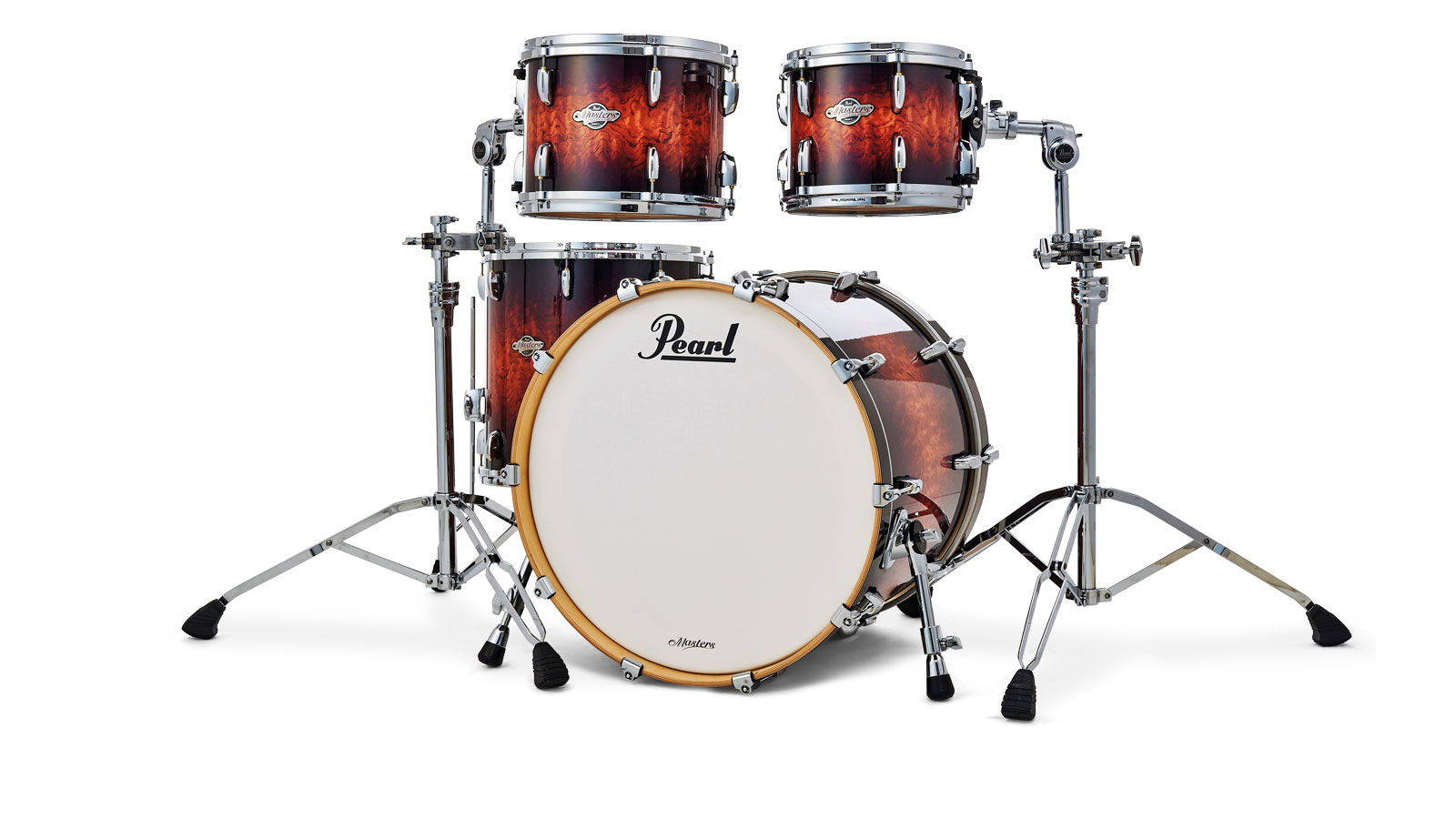MusicRadar Verdict
By offering a restricted choice of shell-packs and finishes Pearl is able to bring to market the professional quality Masters BCX for the price of a top budget kit.
Pros
- +
A superb kit. Perfect for all styles of energetic rocking. Good value for money.
Cons
- -
Not much.
MusicRadar's got your back

Pearl BCX Masters Birch Kit

Rear
Great name, Masters. Of all the big companies, Pearl has probably confused us the most with obscure kit designations like MCX, MLX, WLX, SZX... on and on. But Masters - well, we can understand that. And it is appropriate.
The Masters series has long been a by-word for honest quality. Now Pearl has made the marque available to even more drummers with the BCX, by using the classic ploy of offering restricted finishes and shell-pack options.
Pearl's output is topped by the Masterworks and Reference series, followed by the Masters, then onto the budget Vision and Export.
Within the Masters there is the more expensive thin-shelled Premium Legend (MPL) with 5.4mm maple shells, and Masters Maple Premium (MMP) with four-ply shells and reinforcing rings. Slightly cheaper is the MCX with thicker six-ply maple shells, and now the BCX with six-ply birch shells.
Build
Birch being cheaper to source than maple, the BCX becomes the most affordable deal ever offered on a Masters set. There are four shell-packs, 22"x18" with 10"x8", 12"x9" and either 14"x14" or 16"x16" floor tom (like the review kit); 22"x18" with 12"x9", 13"x10" and 16"x16"; and 20"x18" with 10"x8", 12"x9" and 14"x14" toms.
"When it comes to setting up and tuning, Pearl's years of experience in developing quality hardware at sensible prices shines through"
You can, though, expand your set with a wide range of add-on toms, although these are at the normal, higher prices. And there are matching 14"x5" and 14"x61⁄2" snares (not reviewed).
Pearl differs intriguingly from other big manufacturers - not by being better but by being different - with its shell construction. Unlike the butt-joins of just about every other manufacturer, peep inside a Pearl shell and you'll spot an overlapping scarf joint.
Want all the hottest music and gear news, reviews, deals, features and more, direct to your inbox? Sign up here.
Pearl also reveals that its shell-forming process involves a special glue to saturate the plies, effectively becoming one with the wood when squeezed under 1,000psi at high temperature. Pearl calls this SST or Superior Shell Technology.
At 7.5mm thick the BCX shells are a little stouter than those of most super-expensive drums. The sharp-ish bearing edges are cleanly bevelled at 45° up to the final outer ply which has a small round-over.
Savings are made by offering just three finishes. These are taken from the Artisan II 38-step lacquer finishes and are Super High Gloss Golden Bronze or Silver Glitter, or the Lava Bubinga of the review kit.
Note that this is not a Bubinga veneer, but clever stippling that looks like Bubinga. Pearl maintains this gives Masters drums "the rich look of exotic veneers, without endangering rare wood species". Right-on, if a bit ingenuous. It's most effective though, with a deep sheen and authentic swirling grain which looks neither false nor tacky.
While the Masters is less sophisticated than the expensive Masterworks and Reference, it has everything you need. The SP-30 bass drum spurs, for example, are like the good quality generic spurs fitted to so many so-called 'hand-made' kits. But it's easy to forget that this classic style originated with Pearl. So this is the real thing and does the job splendidly. A simple twist of the huge spring-loaded rubber foot and out pops the sharp spur.
The floor tom leg brackets are also less fancy than some, but are perhaps the better for it, including the simple, small memory locks. And the legs have Pearl's hollowed-out Air Suspension cushioned feet which work so well.
The two small toms have steel OptiMount brackets (Reference and Masterworks have lighter aluminium versions) while bass drums are undrilled. The OptiMount, being bracketed to both top and bottom paired lugs, is one of the most stable ever devised, if bulky. Add the MasterCast hoops and thick shells and the drums are heavy. Chrome plating is superb all around.
Hands On
When it comes to setting up and tuning, Pearl's years of experience in developing quality hardware at sensible prices shines through. Stainless steel tension rods, which are machined, not forged, just fly into the machined brass swivel nuts.
"Powerful with a cracking attack and full tone, it's a superb bass drum"
They slip through the solid ears of the MasterCast hoops and into the bridge lugs with supreme ease - none of the sticking which you find on many high-end drums and which is supposed to hold the tuning better but in fact makes tuning slower and more awkward.
The looseness of the rods and the fact you can get your fingers under the hoops for finger-tightening, makes it easier to achieve even tension and to change heads as great live drums.
The two mounted toms are real biters. The thick-ish birch shells, sharp bearing edges and focusing die-cast rims contribute to a first impression of a quite hard sound. As with quality binoculars where just the slightest turn of the focus ring is all that's needed to get a sharp image, so the tuning of the small toms is sensitive to the smallest tweak.
Between the flat blam of tensioning just above the wrinkles and reaching a high pinging note there is barely a full turn of the rods. But somewhere half-way between, the small toms really come alive with the bright and punchy birch tone, all that you would want and expect.
The full sized 16"x16" floor tom has a slightly wider tuning range and holds the lower tuning particularly well. Having lately become used to so many fashionable 16"x14"s, the extra couple of inches of shell depth was a reminder of just how much body you can get from a big drum like this, even when you tension it relatively high.
Like the floor tom, the bass drum, with the usual perimeter-damped Remo P-3 and full, un-cut white front logo head, also gives a really good account of itself. Set up in my dining room and listening out front while my big powerful son stamps on it, the drum is a monster, reverberating around the room like an earthquake has struck. Powerful with a cracking attack and full tone - a superb bass drum.

Geoff Nicholls is a musician, journalist, author and lecturer based in London. He co-wrote, co-presented and played drums on both series of ‘Rockschool’ for BBC2 in the 1980s. Before that he was a member of original bands signed by Decca, RCA, EMI and more. ‘Rockschool’ led to a parallel career writing articles for many publications, from the Guardian to Mojo, but most notably Rhythm magazine, for which he was the longest serving and most diverse contributor.